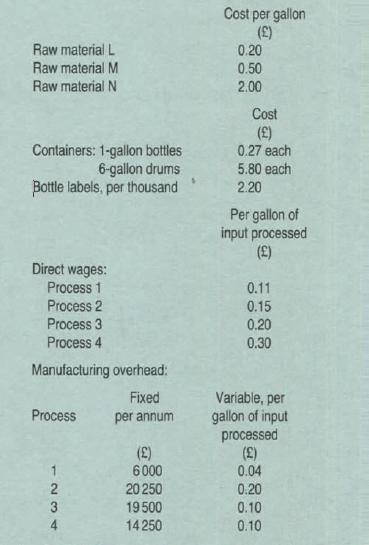Advanced: Calculation of cost per unit, break-even point and a recommended selling price A chemical company produces
Question:
Advanced: Calculation of cost per unit, break-even point and a recommended selling price A chemical company produces amongst its product range two industrial cleaning Huids, A and B. These products are manufactured jointly. In 1979 total sales are expected to be restricted because home trade oullets for Huid B are limited to 54000 gallons for the year. At this level plant capacity will be underutilized by 25%.
From the information given below you are required to:
(a) draw a flow diagram of the operahons;
(b) calculate separately for fluids A and B for the year 1979:
(i) total manufacturing cost;
(ii) manufacturing cost per gallon;
(iii) list price per gallon;
(iv) profit for the year;
(c) calculate the break-even price per gallon to manufacture an extra 3000 gallons of fluid B for export and which would incur selling, distribution and administration costs of £1260;
(d) state the price you would recommend the company should quote per gallon for this export business, with a brief explanation for your decision.
The following data are given:
1. Description of processes Process 1: Raw materials L and M are mixed together and filtered.
There is an evaporation loss of 10%.
Process 2: The mixture from Process 1 is boiled and this reduces the volume by 20%. The remaining liquid distils into 50% extract A, 25% extract B, and 25% by-product C.
Process 3: Two parts of extract A are blended with one part of raw material N, and one part of extract B with one part of raw material N, to form respectively fluids A and B.
Process 4: Fluid A is filled into one-gallon labelled bottles and Huid B into six-gallon preprinted drums and they are then both ready for sale. One percent wastage in labels occurs in this process.
2. Costs

By-product C is collected in bulk by a local company which pays £0.50 per gallon for it and the income is credited to process 2.
Process costs are apportioned entirely to the two main products on the basis of their output from each process.
No inventories of part-finished materials are held at any time.
Ruid A is sold through agents on the basis of list price less 20%
and fluid Bat list price less 331f.l%.
Of the net selling price, profit amounts to 8%, selling and distribution costs to 12% and administration costs to 5%.
Taxation should be ignored.
Step by Step Answer:





